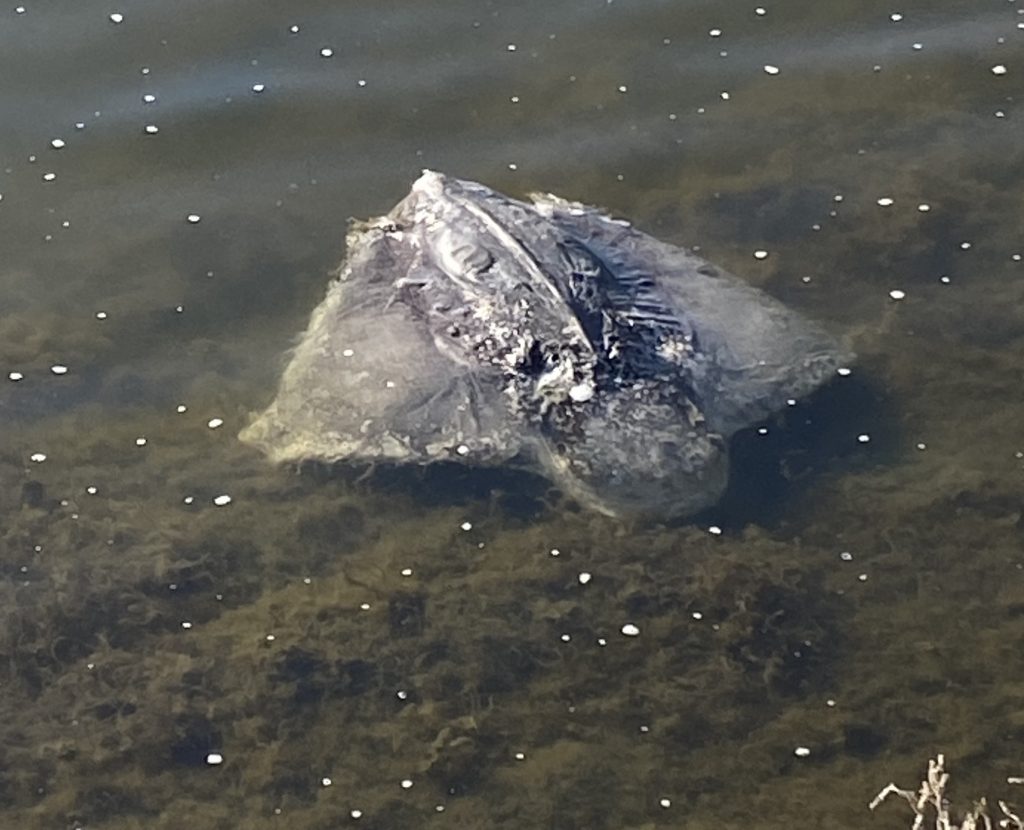In the last two months, numerous reports of dead or dying sharks in the Bay have followed a another die-off in Aquatic Park Berkeley this year. Sharks are being reported struggling in the shallows or washed up dead by concerned citizens from Redwood City, to Point Richmond, to San Francisco and outside the coast north of Bolinas in Marin County in April and May. A few fresh specimens have been collected and examined by California Department of Fish and Wildlife’s (CADFW) pathologist Dr. Mark Okohiro. preliminary results suggest that the sharks were killed by a protozoan infection in the brain. This microbe enters the brain via the shark’s nostrils and ear openings. Although not completely confirmed, Dr. Okohiro suspects the causative agent is the amoeba Miamiensis avidus, the same infectious agent responsible for the mass die off of thousands of fish in 2017. During the years between 2015 and 2016, unseasonably warm sea surface and Bay water temperatures occurred as a result of a marine heatwave in the North Eastern Pacific. This oceanographic condition resulted in starvation and die offs of fish and marine mammals along the California coastline, and a disappearance of many common species.
With waters warming in the Bay and along the coastline, and a predicted El Niño cycle in winter of 2023, this recent episode of shark die-offs has us concerned that the San Francisco Bay and California coastline may be a repeat of 2017. Other species of shark reported recently include the broadnose sevengill shark ((Notorynchus cepedianus) at Pt Richmond CA and a salmon shark (Lamna ditropis) off Bolinas. The leopard shark die off might just be an indicator of things to come.
With The Pelagic Shark Research Foundation shark stranding network and CADFW we are recording, mapping and when possible analyzing recently dead sharks and rays to monitor this year’s shark epidemic.
To document species range, human impacts and encounters our Shark Watch program, Shark Steward’s is collecting observations of live sharks, sharks caught and released or killed, and dead sharks along the California coastline. Observations are entered into a database that will allow scientists and managers better data to make decisions to reduce the conditions impacting marine wildlife in the Bay. This community science program provides beach goers, boaters and other coastal and Bay visitors the opportunity to provide data.

Most Recent Bay Shark Die Off
During the week of February 6, 2023, Shark Stewards recorded nearly 20 dead leopard sharks and bat rays at Berkeley’s Aquatic Park. On the next day, a complete survey of the lagoon was made, counting 41 dead leopard sharks and bat rays in the lagoon. A biologist from Shark Stewards recorded nearly 20 dead leopard sharks and bat rays at Aquatic Park. On the following day, a complete survey of the lagoon was made, counting 41 dead leopard sharks and bat rays in the lagoon.
Like Lake Merritt in Oakland, the Aquatic Park lagoon is a brackish water interior waterway separated from the San Francisco Bay. These enclosed bodies of waters can be mechanically isolated via tidal gates, and receive pollution and excess nutrients from street runoff. Shallow warm waters that are nutrient rich can become an incubator for disease, and without a fresh influx of seawater, can result in high algal growth and also become low in oxygen resulting in the death of aquatic species.
History of Shark Die Offs in the San Francisco Bay
Last August, thousands of Bay fish including sharks washed up and died in Lake Merritt Oakland, and throughout the San Francisco Bay from conditions caused by an event called a Harmful Algal Blooms (HAB).
Baykeeper, a San Francisco Bay watchdog reported that the bay’s high levels of nutrients, mostly phosphorus and nitrogen, discharged from over 40 wastewater treatment plants catalyze the conditions for virus and bacterial proliferation. Longer days and warmer sea temperatures nurture the plant growth, and nutrients spur the proliferation. These nutrients can exacerbate Harmful Algal Blooms.
However, this recent die-off is during a period of cool waters, but also during a period of high run off into Aquatic Park and freshwater dilution of the confined water body.
In the spring of 2017, hundreds of leopard sharks (Triakis semifasciata) and bat rays (Myliobatus californica) washed up dead or dying on the San Francisco Bay shoreline. That event was the second year in a row of mass shark and ray death in the Bay, and the third major die-off since 2011, according to the California Department of Fish and Wildlife. In that case, hundreds of dead shark reports concentrated around Foster City and Redwood City, with additional reports from Hayward, Berkeley, Oakland, and San Francisco. According to pathologist Dr. Mark Okohiro with the California Department of Fish and Wildlife who examined the brains from the sharks, the causative agent was an amoeba Miamiensis avidus that enter via the nose and ear canals and infect the brain.
Tidal lagoons like Aquatic Park, Lake Merritt in Oakland, and those located off Foster City and Redwood City, are subject to polluted street runoff that includes human and animal waste. Periods of high rainfall, such as occurred in early February this year, can also create a lens of freshwater that can create low oxygen conditions and alter the pH of the lagoon. If the tidal gates are closed, fresh saline and oxygen rich seawater is not allowed to enter and mix with the water in Aquatic Park. A construction site located adjacent to the Park could also be a contributing factor.
This isn’t the first large scale leopard shark die-off in the San Francisco area.
Die-offs in San Francisco first gained attention in 1967 when over 725 sharks and rays were recorded by East Bay Park’s biologist Ron Russo. Documented shark and ray die-offs occurred in 2002, 2006, 2011, 2016 and 2017. 2011 had the highest death toll according to Fish and wildlife records.

The Pelagic Shark Research Foundation reported stranded dead sharks in Redwood City, Foster City and a dead shark was reported in Novato to the north suggesting a wider scale disease event. Specimens have been submitted to the California Fish and Wildlife pathologist Dr. Mark Okohiro. The results have not been shared as of yet but Dr. Okihiro has stated he believes the pathogen in the same as the 2017 event.
Sharks and rays belong to the group Elasmobranchii and do not have a swim bladder that helps them flow. Unless nearshore the fish sink and the deaths are not observed. Thus, the reported deaths of stranded sharks and rays are very likely underrepresented. Shark Stewards provided a fresh leopard shark specimen to Dr. Okohiro and contacted the Berkeley Parks and Department of Public Works to conduct water testing and examine the tidal gates to ensure fresh seawater is entering Aquatic Park.
Report a stranded or dying shark in California below, call or text the California Department of Fish and Wildlife’s CalTIP hotline. You can also take a picture and upload it iNaturalist, where it will be added to a project tracking leopard sharks and bat rays around the Bay.
©DavidMcGuire Shark Stewards.org Copying or deriving any material; on this website without permission is a violation of copyright law.